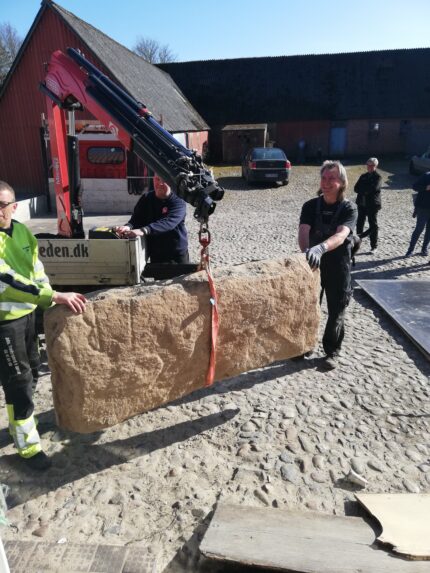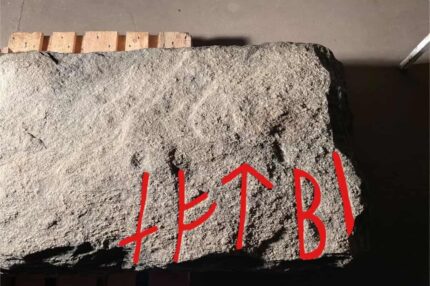 A massive rune stone discovered under the kitchen floor of a farm in Mosekær, Denmark, may be one of the country’s oldest.
A massive rune stone discovered under the kitchen floor of a farm in Mosekær, Denmark, may be one of the country’s oldest.
Homeowners Lene Brandt and her husband Anders Nielsen were renovating their mid-19th century farmhouse, when they exposed a large stone after pulling up the old linoleum flooring in the kitchen. They tried to dig it out, but by the time they were done, they’d unearthed a stone more than 6.5 feet long and 2.6 feet wide weighing close to a ton. A neighbor kindly offered to come over and cut it in half to help them get it out of there, but they declined, much to history’s relief.
Viking Age artifacts have been found in the area before, so Brandt and Nielsen decided to call in an archaeologist from the Museum East Jutland to examine the stone before removing it. Viewing the top of the stone, the archaeologist deemed it to have been shaped more recently than the Viking Age, so the owners turned their attention to challenges of moving so huge and heavy a stone in one piece.
 Helle Nielsen, a metal detectorist friend of Lene’s saw pictures on Facebook of the stone being craned out of the house and spotted some faint markings on the back. She thought they might be runes, and asked a friend of hers who works for the museum to take a look. They sent photos of the back, which the first archaeologist had never seen, to the Museum of East Jutland, and this time they recognized that it was a Viking Age rune stone.
Helle Nielsen, a metal detectorist friend of Lene’s saw pictures on Facebook of the stone being craned out of the house and spotted some faint markings on the back. She thought they might be runes, and asked a friend of hers who works for the museum to take a look. They sent photos of the back, which the first archaeologist had never seen, to the Museum of East Jutland, and this time they recognized that it was a Viking Age rune stone.
It was a significant find, the first rune stone found in the area in 27 years. The last one had been recycled as building material too, incorporated into the construction of Borup Church. This was a common practice in the 19th century when the farmhouse was built, and while the relocation divorced the stone from its original context and all the information that would have come from that, it also confirms its authenticity. There was no interest in creating forged runes in the 19th century, especially not a handful of faint ones on a slab destined to become part of a kitchen floor.
 Only five runes have been identified on the stone. National Museum runologist Lisbeth Imer reads them as “Aft bi,” which translates to “after B-.” Monumental rune stones were often erected as memorials, so it’s likely the B was the first letter of the name of the person being memorialized, perhaps a Birk or a Bjørn.
Only five runes have been identified on the stone. National Museum runologist Lisbeth Imer reads them as “Aft bi,” which translates to “after B-.” Monumental rune stones were often erected as memorials, so it’s likely the B was the first letter of the name of the person being memorialized, perhaps a Birk or a Bjørn.
Determining its date is difficult, but the style of the inscription and typology of the runes suggest they are very old. Typologically speaking, if the runes were the beginning of a sentence rather than the end of one, they were carved very early, likely in the 8th century. There are only ten or 20 rune stones of that age in Denmark.
The stone has been declared danefæ, Denmark’s version of treasure trove. It is now at the Museum of East Jutland where it is undergoing further analysis to narrow down its age and interpret the runes.